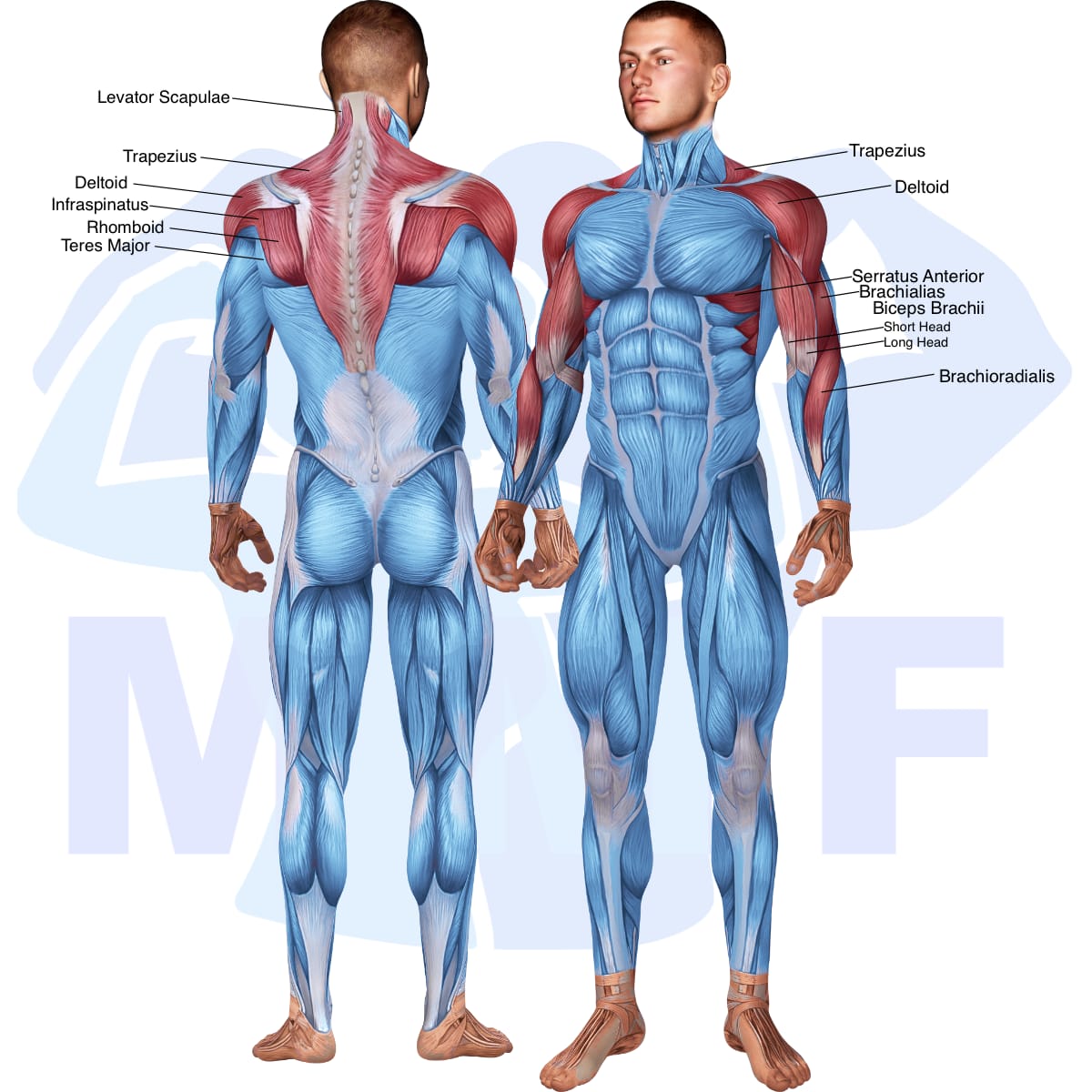Are you tired of feeling shoulder pain after doing the barbell standing upright row? Don’t worry, you’re not alone. This exercise can be challenging for many gym-goers, and shoulder pain can be a very common result. The good news is that this pain is often caused by poor form or incorrect execution of the exercise. By following the tips and techniques outlined in this post, you’ll be able to perfect your form and perform the barbell standing upright row with confidence, without any nagging shoulder pain.
Barbell Standing Upright Row Summary
- Primary Muscles: Deltoid – Lateral
- Secondary Muscles: Biceps Brachii, Brachialis, Brachioradialis, Deltoid – Anterior, Infraspinatus, Serratus Anterior, Teres Minor, Trapezius – Lower, and Trapezius – Middle
- Equipment: Barbell
- Mechanics Type: Compound
- Force: Pull
- Utility: Basic or Auxiliary

Barbell Standing Upright Row Instructions
- Grab the bar with a shoulder-width overhand grip.
- Next, pull the barbell to your chin with your elbows leading up.
- Allow your wrists to flex as you raise the bar.
- At the top ensure your elbows are higher than the wrists.
- While keeping your back straight slowly return the barbell to the starting position.
- Repeat until your set is complete.
Video Tutorial
Barbell Standing Upright Row Muscles
Target (Agonist)
Synergists
- Biceps Brachii
- Brachialis
- Brachioradialis
- Deltoid – Anterior
- Infraspinatus
- Rhomboid
- Serratus Anterior
- Teres Minor
- Trapezius – Lower
- Trapezius – Middle
Dynamic Stabilizers
- None
Stabilizers
- Levator Scapulae
- Trapezius – Upper
Antagonist Stabilizers
- None

Benefits of Barbell Standing Upright Row
The Barbell Standing Upright Row is an excellent exercise for strengthening the Deltoid – Lateral, which is a major muscle group used in everyday activities. This exercise requires the use of a barbell and targets the Deltoid – Lateral, helping to increase strength, endurance, and overall muscle size. The Barbell Standing Upright Row also helps to improve posture, as well as stabilize and strengthen the shoulders and arms. By strengthening the Deltoid – Lateral, this exercise helps to reduce the risk of shoulder and arm injuries. Additionally, because this exercise works the entire upper body, it can be beneficial in helping to improve overall body composition and performance.
Tips for Performing Barbell Standing Upright Row
This exercise is great for targeting the shoulders, upper back, and arms. To get the most out of your Barbell Standing Upright Row, it’s important to use proper form and technique. Here are some tips to help you get the most out of this exercise:
- Balance The Weight To Make Sure You Exercise Symmetrically.
- help reduce muscle soreness by conducting only a few minutes of cardio focusing on your target muscles to finish your workouts. This cardiovascular exercise is removing much of the lactic acid. Subsequently, you shall be enhancing your healing period.
- Alternate Your Training Sets Randomly With Varied Weight And Repetition Combinations. For instance 3 set of 8-12 for a few weeks then 5 sets of 5 reps for a week or two.
- Slow All Rep To Just Under 6 Seconds For Every Contraction And The Same For The Extension, To Speed Up Your Exercise Session. So that you will generate mass, you need to increase the amount of time under strain of your target muscle tissue. Going slower your rep will raise the time period under strain. Numerous research papers have found that about 5 seconds of extension and contraction is the ideal time to provide optimum benefit for developing muscle bulk. You want to add this method now and again, although not every time you lift.
Benefits and Tips Video
Frequent Mistakes To Avoid
It’s important to remember that the Barbell Standing Upright Row is an effective exercise for building strength and improving posture, but it’s also important to be aware of potential mistakes that can occur while performing the exercise. To ensure you get the most out of your workout, here are some common mistakes to avoid when doing the barbell standing upright row.
- Stop Trying To Make It To Easy. The only way to improve strength will be to challenge yourself.
- Don’t Relax Your Abs. Maintaining your abs tight to protect your back by maintaining your internal pressure.
- You Must Not Dismiss Your Own Pains. Sore muscle tissue and an injury pain are definitely not always the same. Whenever you experience discomfort any time you are exercising you should stop, or you could simply just make this injury more serious.
Find More Barbell Exercises Here
Variations and Complementary Exercises
If you’re looking for other exercises to add to your routine that work similar muscles as the barbell standing upright row, here are some variations, complementary, and alternative exercises for you to try:
Barbell Wide Grip Upright Row

The Barbell Wide Grip Upright Row is a great alternative or complementary exercise to the Barbell Standing Upright Row. This exercise helps to target the shoulders and arms, and it also engages the core. To perform this exercise, you will stand with your feet shoulder-width apart and hold a barbell with an overhand grip that is wider than shoulder width. You will then lift the barbell up towards your chest and pause before slowly lowering it back down. The benefit of this exercise is that it works the muscles of the arms and shoulders from a different angle than the Barbell Standing Upright Row, allowing you to develop more balanced upper body strength.
Cable Front Raises

Cable Front Raises are an excellent complementary or alternative exercise for Barbell Standing Upright Row. This exercise targets the front deltoids and can be done with a variety of weights and cable machines. The motion for this exercise is to stand with feet slightly wider than shoulder-width apart, hold the cable handle with both hands, and raise the arms out in front of you. This exercise is great for adding size and definition to the front deltoids, as well as increasing strength. It also helps improve posture by strengthening the upper back muscles.
Cable Seated Rear Lateral Raise

The cable seated rear lateral raise is a great exercise to complement the barbell standing upright row. It works the same muscles as the barbell standing upright row but in a different way. This exercise focuses on strengthening the rear deltoids, which are often neglected during barbell standing upright rows. By using cables, you can adjust the weight to your desired level and also focus on different areas of your shoulder muscles. This exercise can also be used as an alternative for those who may find barbell standing upright rows too difficult or uncomfortable.
Check Out These Top Barbell Exercises
Cable Single Arm Forward Raise

The Cable Single Arm Forward Raise is an excellent exercise for targeting the shoulder muscles, and it is a great alternative or complementary exercise for the Barbell Standing Upright Row. The Cable Single Arm Forward Raise works the shoulder muscles in a different way than the Barbell Standing Upright Row by engaging more of the anterior deltoid and less of the trapezius. It also helps to strengthen stabilizing muscles, which can help improve shoulder stability and reduce the risk of injury. The Cable Single Arm Forward Raise is a great way to add variety to your shoulder routine, and it can be used to target specific muscles for further development.
Dumbbell Around The World

Dumbbell Around The World is a great complementary exercise to the Barbell Standing Upright Row. The movement for this exercise involves raising both dumbbells in an arc pattern, starting from the sides of the body, out and around the head, and back down to the starting position. This exercise helps to work the shoulders and upper back muscles, while also engaging the core muscles to stabilize the body. Because of its arc pattern, it works the muscles in different planes than the Barbell Standing Upright Row, making it an ideal alternative exercise for targeting different muscle groups.
Dumbbell Front Raise

The Dumbbell Front Raise is a great exercise for building shoulder strength and stability. It is a complement to the Barbell Standing Upright Row, as it works the same muscle groups in a slightly different way. The Dumbbell Front Raise requires you to lift the weights in front of your body rather than to your sides, as in the Barbell Standing Upright Row. This helps to target different muscles of the shoulder, as well as to work on shoulder stability by forcing you to balance the weights throughout the movement. The Dumbbell Front Raise is also a great alternative exercise if you don’t have access to a barbell.
Find More Shoulders Exercises Here
Opposing Complementary Exercises
To further complement the exercise Barbell Standing Upright Row, it is beneficial to incorporate exercises that work the opposing muscle groups. This helps to maintain balanced strength and prevent any muscle imbalances. Below are a few exercises to help achieve this goal.
Pec Deck (Machine)

The Pec Deck machine is a great complementary exercise to Barbell Standing Upright Row. It works the opposing muscle groups of the chest, providing a balanced workout for the upper body. This machine allows for a greater range of motion than the Barbell Standing Upright Row, allowing for an increased range of motion in the chest muscles. The Pec Deck also offers a greater degree of control and stability, allowing for a more effective workout with fewer chances of injury. By using the opposing muscle group, the Pec Deck helps to build strength and balance in the upper body while avoiding overtraining of any single muscle group.
Lever Seated Fly (Machine)

The Lever Seated Fly is an excellent machine for targeting the opposing muscle group of the Barbell Standing Upright Row. This machine works the chest and back muscles in a unique way, by having the user sit down while grasping two levers connected to a weight stack. The user then pushes the levers away from the body, in a butterfly-like motion, which stretches and strengthens the chest muscles. This movement is complementary to the Barbell Standing Upright Row, as it targets the opposing muscle group and helps create a balanced workout.
Lever Chest Press (Machine)

The Lever Chest Press machine is a great complement to the Barbell Standing Upright Row exercise because it works the opposing muscle group. This machine targets the chest muscles, which are the antagonist muscles of the shoulder muscles that are worked with the Upright Row. The Lever Chest Press helps to ensure balanced strength between opposing muscle groups, while also helping to increase overall upper body strength and stability. The Lever Chest Press helps to add variety to an upper body workout and can be used as a primary or supplemental exercise.
Master The Barbell Upright Row And Elevate Your Strength Today!
If you’re looking to elevate your strength and build those shoulders, then mastering the barbell standing upright row is a must. Not only does it target your deltoids, but it also engages your traps and upper back muscles, giving you a well-rounded upper body workout. However, it’s important to remember that proper form is key to avoid injury and maximize results. Make sure to start with a lighter weight and focus on pulling the barbell up towards your chin in a controlled manner. As you progress, increase the weight gradually and always listen to your body. With patience and consistent practice, you’ll soon be a pro at the barbell standing upright row!
References: Wikipedia | ExRx.net | PubMed.gov | Comprehensive List of Shoulders Barbell Exercises




